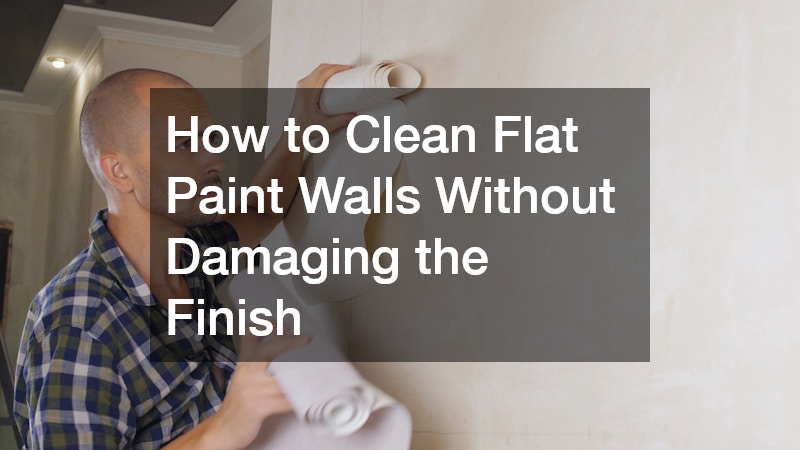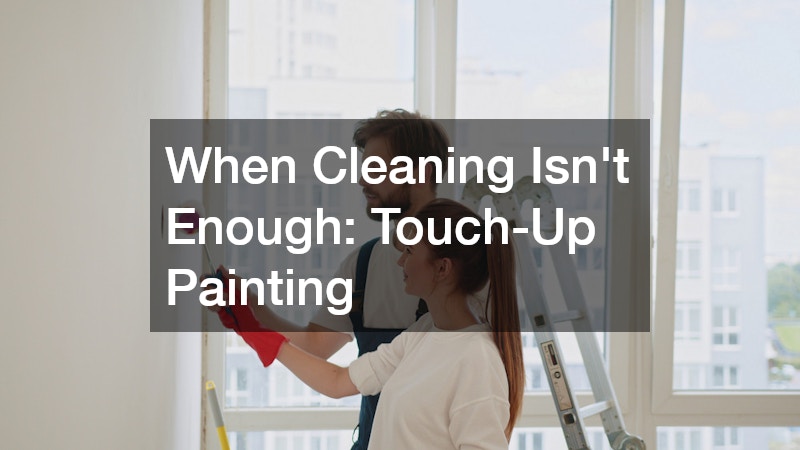How to Clean Flat Paint Walls Without Damaging the Finish

Flat paint is a popular choice for walls because it offers a smooth, matte look that hides imperfections well. However, it’s also known for being tricky to clean. Unlike glossy finishes, flat paint can easily show watermarks, streaks, or even wear spots if you scrub too hard.
This guide will walk you through how to clean flat paint walls the right way — keeping your home looking fresh while protecting your wall finish.
Why Flat Paint Is Tricky to Clean
Before diving into the cleaning process, it’s important to understand why flat paint requires special care:
- Porous surface – Flat paint absorbs more moisture than glossy finishes, making it prone to water stains.
- Low sheen – Because it doesn’t reflect much light, any scrub marks or worn spots are more visible.
- Easily damaged – Aggressive cleaning can cause the paint to fade or peel in spots.
Knowing this helps you approach cleaning with the right techniques and tools.
When to Clean Flat Paint Walls
You don’t always need to deep clean your walls, but there are certain times when a gentle wash is a good idea:
- Before hosting guests – Fresh walls make a great impression.
- After spills or splashes – Especially in kitchens or dining areas.
- Seasonal cleaning – Once or twice a year to remove dust buildup.
- After moving furniture – To clear any scuff marks or handprints.
For everyday upkeep, dusting or spot-cleaning is often enough.
Supplies You’ll Need
Gathering the right cleaning supplies beforehand will make the process smoother and help you avoid damage.
Basic Supplies:
- Soft microfiber cloths
- Sponge (non-abrasive)
- Mild dish soap
- Two buckets (one for cleaning solution, one for rinsing)
- Warm water
- Step ladder (for high spots)
- Feather duster or dry microfiber mop
Optional Supplies for Stubborn Stains:
- White vinegar (diluted)
- Baking soda paste (for tough spots)
- Touch-up paint (for damage that can’t be cleaned away)
Step-by-Step Guide: How to Clean Flat Paint Walls
Step 1: Dust the Walls
Before introducing any moisture, you need to remove loose dirt, dust, and cobwebs.
- Use a microfiber mop, an electrostatic dusting cloth, or a feather duster for best results.
- Always work from top to bottom so debris doesn’t fall onto areas you’ve already cleaned.
- Pay extra attention to corners, baseboards, and along the tops of door frames where dust collects.
- For stubborn cobwebs, gently use a vacuum with a brush attachment.
Why it matters: Dust mixed with water can create muddy streaks on flat paint, making the wall look worse instead of cleaner.
Step 2: Test a Small Spot First
Flat paint can be delicate and may react differently depending on its age, quality, and how it was applied.
- Choose an inconspicuous area (like behind furniture or near the floor).
- Apply a small amount of your cleaning solution with a soft cloth.
- Gently blot and let it fully dry before checking for any color fading, streaks, or surface texture changes.
Tip: If you notice damage or discoloration, switch to a gentler cleaning solution or consider touching up with paint instead of attempting full cleaning.
Step 3: Prepare the Cleaning Solution
You need a safe, gentle cleaner that won’t damage your flat paint.
- Mix 1 teaspoon of mild dish soap with 1 quart of warm water in a bucket.
- Stir gently so you don’t create excessive suds.
- Avoid harsh chemicals, strong detergents, or ammonia-based cleaners — they can strip or discolor paint.
Optional: For extra stain-fighting power, add a drop of white vinegar to help cut through light grease.
Step 4: Spot-Clean Stains First
Address visible marks before cleaning the whole wall.
- Dip a microfiber cloth into the solution and wring it out thoroughly — the cloth should be damp, not soaking wet.
- Gently blot the stain. Avoid rubbing, as this can damage the flat finish.
- For greasy marks, use your water-vinegar mix, then blot with clean water to remove any residue.
Why it works: Spot-cleaning prevents stains from spreading when you do the full wall wash.
Step 5: Wash the Wall in Sections
If the entire wall needs cleaning:
- Work in small sections, starting at the top and moving downward.
- Use a lightly dampened sponge or soft cloth, applying gentle circular motions.
- Rinse your sponge in clean water often to avoid redistributing dirt.
- Never scrub aggressively — too much pressure can lift the paint.
Pro Tip: Keep two buckets — one with your cleaning solution and one with clean rinse water — for more efficient cleaning.
Step 6: Dry the Wall
Moisture left on flat paint can leave streaks or watermarks.
- Use a clean, dry microfiber cloth to blot (not rub) the surface.
- Work in the same order you cleaned, from top to bottom.
- Make sure the wall is completely dry before moving furniture or hanging anything back.
Extra Care: If you see any areas where the paint has thinned or faded, you can do a light touch-up with matching paint after the wall has dried fully.
Dealing with Stubborn Stains on Flat Paint
Some marks are more stubborn than others. Here’s how to tackle them without ruining your walls:
- Scuff Marks – Try a damp magic eraser very gently. Test in a hidden spot first, as these can remove paint.
- Grease Stains – Use diluted vinegar and water. Blot, don’t rub.
- Crayon or Ink – A baking soda paste (baking soda + water) can work, but proceed with caution.
- Water Stains – Often these are permanent on flat paint. Spot-repainting may be the best fix.
Preventing Future Stains on Flat Paint Walls
While flat paint is more delicate and prone to marks, you can extend its fresh, clean look by taking some proactive steps. A few simple habits can make a big difference in reducing the need for frequent scrubbing or repainting.
Tips to Keep Flat Paint Walls Looking Fresh:
- Opt for washable flat paint varieties when repainting, as these offer better resistance to stains and are easier to clean without damaging the finish.
- Minimise hand contact on high-touch areas such as hallways and near light switches, or clean these spots gently as soon as marks appear.
- Avoid placing furniture directly against walls, which can cause scuffs and dents over time—leave a small gap to protect the surface.
- Place mats or rugs near entryways to catch dirt, dust, and debris before it reaches your walls.
By combining these preventive measures with gentle cleaning techniques, you’ll help preserve your walls’ smooth, even finish for much longer.
When Cleaning Isn’t Enough: Touch-Up Painting
Sometimes, even after a thorough cleaning, certain marks, stains, or discoloration just won’t disappear. In these situations, a quick touch-up can restore your wall’s fresh, uniform appearance without the need for a full repaint.
Steps for Touch-Ups:
- Match your existing paint color and sheen. Use leftover paint from the original job if possible. If you don’t have any, take a small chip or a high-quality photo to the paint store for a match.
- Clean the area thoroughly. Remove dust, dirt, or grease with a gentle cleaner so the paint adheres properly.
- Lightly sand if needed for smooth blending. Use fine-grit sandpaper to smooth the surface and feather the edges for a seamless look.
- Apply paint in thin, feathered layers. Use a small brush or roller, blending the new paint into the surrounding area to avoid noticeable edges.
Common Mistakes to Avoid
Over-scrubbing – Scrubbing too hard may seem like the quickest way to remove marks, but it can create shiny patches, scratch the paint, or completely strip it off. Use gentle pressure and a soft sponge or cloth instead.
Too much water – Excess water can seep into the wall, especially with flat or matte paint, leading to bubbling, warping, or mold growth. Always wring out your cleaning cloth or sponge so it’s damp, not dripping.
Harsh cleaners – Strong chemicals, such as bleach or abrasive powders, can remove paint layers and leave visible discoloration. Opt for mild detergents or paint-safe cleaning solutions to preserve the wall’s appearance.
Skipping the test spot – Failing to test your cleaner on a small, hidden area first increases the risk of damaging a large section of the wall. A quick test can save you from costly repairs.
Quick Maintenance Routine for Flat Paint Walls
If you want your walls to stay fresh without deep cleaning too often:
- Weekly – Dust walls lightly.
- Monthly – Spot-clean high-traffic areas.
- Twice a year – Do a full gentle wash.
Conclusion
Keeping your flat paint walls clean doesn’t have to be stressful. By using the right tools, gentle cleaners, and proper techniques, you can remove dirt, fingerprints, and scuff marks without damaging the paint’s smooth, non-reflective finish. Always remember to start with the mildest cleaning solution and work your way up if needed. Regular dusting and spot cleaning can help prevent buildup, making deep cleaning less frequent and easier to manage.
Flat paint offers a beautiful, modern look, but it does require extra care to maintain its charm. With a little patience and the steps outlined in this guide, your walls can stay fresh, bright, and damage-free for years. Whether you’re touching up a single spot or giving an entire wall a refresh, the key is to be gentle and consistent. Treat your walls well, and they’ll keep enhancing your home’s style and comfort.



